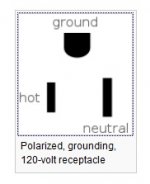Jess:
Just a little addendum to what your electrician told you FYI. A Ground Fault Interrupter (usually found in an AC outlet, but not necessarily) measures the amount of electrical current flow in the hot wire to the load, also measures the amount of current in the neutral wire returning from the load, and compares the amount of the 2 currents. If these values are different by 4 to 6 1000's of an ampere (4-6 milliamps) the GFI ASSUMES this missing return current is going through a persons's body electrically shocking them, and turns of the electrical current by almost instantaneously turning off an electrical relay. This assumption of a person being shocked is very often not true, but this safety device assumes the worst case scenario.
Other things can cause the leakage of electrical current (usually to the protective ground wire) within an electrical device, tripping the GFI. I once stayed in a campground near Seattle, and at the time they were near full, so the only space I could get had power provided by a 15 amp GFI outlet. All was well overnight, as I very critically watch my electrical current consumption on a less than 50 amp supply. The next morning I cooked something in the microwave for a couple of minutes, then a few minutes AFTER microwave cooking the GFI outside tripped. I troubleshot the problem down to condensation moisture in the microwave oven from the food that formed a leakage current path from hot to ground within the microwave. Air drying the microwave out for a few hours got rid of the GFI trip.
In my career as a hospital biomedical equipment technician checking all corded devices for leakage was a daily chore. Electrical safety standards in the healthcare industry are extremely tight to prevent electrical accidents on patients with wires on/in their bodies lying on metal grounded frame hospital beds. The standard for patient care equipment is 10 microamps of leakage (10 millionths of an ampere). When the earliest personal computers and personal computer-based medical devices arrived on the scene in hospitals, they were ALL failing the 10 microamperes electrical leakage standard. I did and "autopsy" on one of these first PCs, and found that it had an included power line noise filter (required by the FCC to minimize digital noise being radiated back into the AC power distribution system). Unfortunately, this standard filter design used on MOST ALL line powered digital devices still today uses what we call a split capacitor - 2 capacitors, 1 connected between the hot wire and ground and one capacitor located between the neutral wire and ground. Capacitors pass alternating current, the lower the AC frequency, the less they pass. But even at the extremely low frequency of 60 Hertz that we use for AC power in the U.S. these filter capacitors pass enough AC current to exceed the 10 microamp medical device limits. Hence the filter manufacturers had to come up with a class of "Medical Grade" power line filters which omitted the split capacitors to meet the medical leakage current requirements sacrificing some reduction of radiated digital AC power noise.
BTW, your battery system converter/charger is most likely a switched mode DC power supply, using digital pulses of AC power to produce the regulated DC power for your 12 volt system most efficiently. So I would expect it to have the split capacitor filter. Switched mode power supplies are also found microwaves, computer power supplies and TV's.
Last of all, in my 65 years of life I have seen many technological changes. I remember as a kid as I read my local hometown newspaper daily and many times a year reading of people being electrocuted with ordinary AC power accidents. As the GFI's came online and became required by electrical code, I realized that I was reading about less and less of these electrocution accidents. The linked article on GFI's (a VERY good article in my opionin) cites a reduction of consumer electrocutions from over 600 in the U.S in the late 1960's to 280 in the 1988. It's been almost 30 years since 1988, and I would think the accidental electrocution by consumer devices figure must have been going down more and more since then. Here is the link:
http://ecmweb.com/content/think-gfci
I hope this wasn't too long-winded, and helps someone with understanding GFI's and the potential problems with them. It might also help anyone in a hospital bed with feeling more secure that the hospital biomeds and engineers out there are looking out for their electrical safety.

